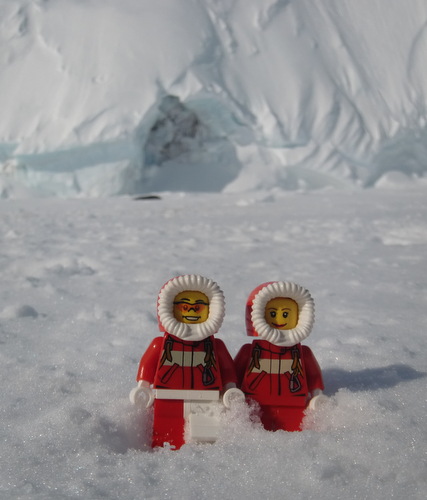 This journal is brought to you by…
This journal is brought to you by…
This journal is brought to you by…
- Ms. Wieczorek’s 3rd grade class from Peru Catholic School in Illinois
- Ms. Porter’s 2nd grade class from Hope Sullivan, MS
- Mr. John Trego’s 6th grade class at Mirror Lake Middle School
Crosswind Elementary Students:
Jax Petrouski in 3rd grade
- Kailyn Lambert
- Benjamin Derieg in 1st grade
- Cristina Hethmon in 5th grade
About Antarctica: Mt. Erebus
 About Antarctica! Image credit: Lindsey Newton.
About Antarctica! Image credit: Lindsey Newton.
One of the challenges on the ice in Antarctica is finding our way. It’s easy to get lost when you’re surrounded by ice, snow and sky! So how do we remedy this situation?
We use landmarks! But these aren’t the landmarks we‘re familiar with back home. There are no businesses, street signs or tall buildings to help us find our way. We use land features to orient ourselves! Some of these include Tent Island, Hutton Cliffs, Big Razorback and Little Razorback Islands.
But none are as prominent as Mt. Erebus.
 Bruce Bulkfigure and Molly Minifig enjoying the ice near Mt. Erebus. Photo credit: Alex Eilers.
Bruce Bulkfigure and Molly Minifig enjoying the ice near Mt. Erebus. Photo credit: Alex Eilers.
Mt. Erebus
While out seal searching, we can usually see Mt. Erebus gently smoking in the distance. That’s right, I said smoking. This is no ordinary mountain – this is a volcano!
 Mt. Erebus smoking in the distance. Well, most of what you see above Mt. Erebus are the clouds but if you look closely at the peak you can see a little smoke. Photo credit: Alex Eilers.
Mt. Erebus smoking in the distance. Well, most of what you see above Mt. Erebus are the clouds but if you look closely at the peak you can see a little smoke. Photo credit: Alex Eilers.
Mt. Erebus is the southernmost active volcano in the world. It was discovered in 1841 by James Clark Ross. It was easy for him to spot – it was erupting!
Mt. Erebus erupts a lot, sometimes more than once a day! Check out this video of Mt. Erebus erupting!
Mt. Erebus also has one of only five constant lava lakes found in the world. A lava lake is just what it sounds like – a lake of molten (liquid) lava contained in the crater of a volcano! Most volcanos don’t have lava lakes because the lava on top has hardened; in other words, it’s no longer molten.
 Here is a great view of the Mt. Erebus lava lake. Photo credit: Carsten Peter.
Here is a great view of the Mt. Erebus lava lake. Photo credit: Carsten Peter.
Picture credit: National Geographic
Mt. Erebus often spews lava and lava bombs, which are globs of gooey lava that are shot in the air by the force of the eruption. These lava bombs can fly as far as a mile away from Mt. Erebus and can be up to ten feet wide! That made me a bit nervous – what if I got hit in the head with a lava bomb? Not to worry! My research team assured me this is very unlikely. The only people really at risk are the researchers who study Mt. Erebus, and they get a lot of training in lava bomb dodging!
Because of these lava bombs and constant eruptions, this mountain is actually covered in crystals. When lava cools quickly, it turns into crystals, and these crystals can be found all over the mountain.
 Look at these crystalized lava bombs. Photo credit: Alan Light.
Look at these crystalized lava bombs. Photo credit: Alan Light.
Picture credit: Flickr.com
Mt. Erebus is also surrounded by ice caves. These are incredibly beautiful caves that are formed by cracks in the earth’s crust. These cracks – or fumaroles – emit hot gases which melt the surrounding snow and ice. This makes a cave. Venturing into these caves can be dangerous. Sometimes researchers have to rappel down into them! It would be very exciting, but I think I’ll leave that to the professionals!
 These ice caves are so beautiful! Photo credit: Peter Rejcek.
These ice caves are so beautiful! Photo credit: Peter Rejcek.
Picture credit: The Antarctic Sun
But if you are interested ice caves, check out my post and video here
Here are some more fun facts about Mt. Erebus!
Mt. Erebus is the second tallest volcano in Antarctica.
Mt. Erebus is 12,451 feet tall!
Erebus is classified as an ‘ultra’ mountain, which means that its summit reaches more than 10,000 feet above sea level.
Mt. Erebus is one of 35 volcanos in Antarctica.
Mt. Erebus is named after one of James Clark Ross’s ships, Erebus.
The lava in the lava lake is about 1,700 degrees F.
 Aerial view of Mt. Erebus. Photo credit: Carsten Peter.
Aerial view of Mt. Erebus. Photo credit: Carsten Peter.
Picture credit: National Geographic


Comments